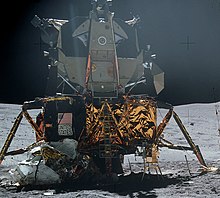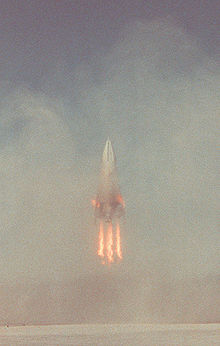
Back Enlairament i aterratge vertical (coet) Catalan Véhicule à décollage et atterrissage verticaux French Lepas landas dan pendaratan vertikal ID VTVL Italian 垂直離着陸ロケット Japanese VTVL Portuguese วีทีวีแอล Thai 垂直起降 (火箭) Chinese



Vertical takeoff, vertical landing (VTVL) is a form of takeoff and landing for rockets. Multiple VTVL craft have flown. The most successful VTVL vehicle was the Apollo Lunar Module which delivered the first humans to the Moon. Building on the decades of development, SpaceX utilised the VTVL concept for its flagship Falcon 9 first stage, which has delivered over two hundred successful powered landings so far.
VTVL technologies were first seriously developed for the Apollo program. By the '90s, development on large reliable restartable rocket engines made it possible to use the already matured technology for rocket stages. The first pioneer was the McDonnell Douglas DC-X demonstrator. After the success of the DC-X prototype, the concept was developed substantially with small rockets after 2000, in part due to incentive prize competitions like the Lunar Lander Challenge.
Starting in the mid-2000s, VTVL was under intense development as a technology for reusable rockets large enough to transport people. From 2005 to 2007 Blue Origin did a series of successful tests, first with the jet powered Charon demonstrator, later using the Goddard demonstrator. Small VTVL rockets were also developed by Masten Space Systems, Armadillo Aerospace, and others. In 2013, after the failure of stage recovery with parachutes, SpaceX demonstrated vertical landing on a Falcon 9 prototype after climbing 744 meters in the air.[1] Later, Blue Origin (New Shepard) and SpaceX (Falcon 9), both demonstrated recovery of launch vehicles after return to the launch site (RTLS) operations, with Blue Origin's New Shepard booster rocket making the first successful vertical landing on November 23, 2015, following a flight that reached outer space, and SpaceX's Falcon 9 flight 20 marking the first landing of a commercial orbital booster roughly a month later, on December 22, 2015. All but one launch of the SpaceX Falcon Heavy have included VTVL attempts for the two side boosters on each rocket. SpaceX is also developing a fully reusable rocket named Starship.[2]
VTVL rockets are not to be confused with aircraft that take off and land vertically and use air for support and propulsion, such as helicopters and jump jets which are VTOL aircraft.
- ^ February 2016, Elizabeth Howell 06. "SpaceX's Grasshopper: Reusable Rocket Prototype". Space.com. Archived from the original on 2021-01-16. Retrieved 2021-01-18.
{{cite web}}: CS1 maint: numeric names: authors list (link) - ^ "SpaceX". SpaceX. Archived from the original on 2011-03-07. Retrieved 2021-05-26.
© MMXXIII Rich X Search. We shall prevail. All rights reserved. Rich X Search